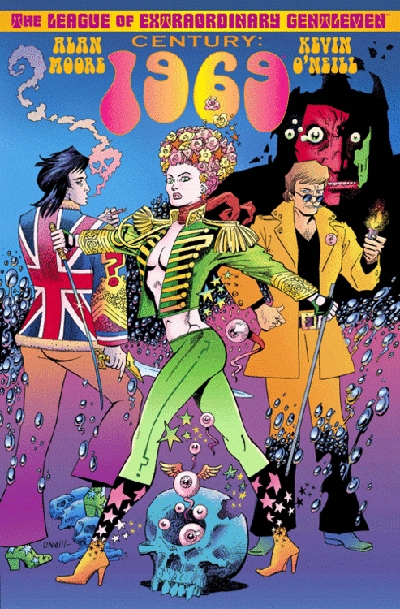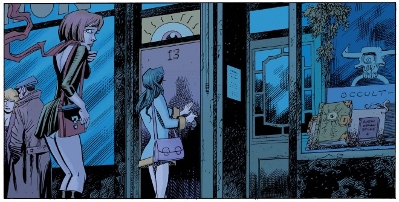|
The League
of Extraordinary Gentlemen Century 1969

The League Of Extraordinary
Gentlemen Century 1969 is the second installment of the Volume III
Century trilogy in Alan Moore's classic comic book series. The premise
of the comic is that of an alternate reality where famous fictional
characters are real and all co-exist together. The League Of
Extraordinary Gentlemen is a clandestine organisation rather like a
superhero team formed to protect Britain and its interests. Members
over the years and centuries have included Prospero, Gulliver, The
Invisible Man, Captain Nemo, and Dr Jekyll/Mr Hyde. Now it is 1969 and
they are down to three. Mina Murray (from Bram Stoker's Dracula), Allan
Quatermain (from H Rider Haggard's King Solomon's Mines) and Virginia
Woolf's gender bending Orlando. Orlando is immortal while Alan and Mina
have taken a dip in an African fountain of youth (from Haggard's SHE)
and are now perpetually young.
The story picks up with them
being dropped off at the white cliffs of Blighty by the mighty
steampunk submarine Nautilus (now under the command of Nemo's daughter)
where they head for the neon frazzled hippy swinging London of the late
sixties. Their mission is to stop darkly mystic cult leader Oliver
Haddo (who appeared in Somerset Maugham's novel The Magician and is
based on Aleister Crowley) from creating a Moonchild or anti-Christ
(references to Rosemary's Baby and The Omen here amongst others). Haddo
is dead now but still an ominous scheming presence in astral form. As
our heroes immerse themselves in the psychedelic glitter and free love
drug trippage of the era, the intrigue envelops the debauched world of
pop music and draws in some notorious gangsters. With more famous
cameos than you can shake a Harry H Corbett at the game is afoot.

Although Alan Moore is becoming
more indulgent, esoteric, obtuse even as the Century series slowly
unfurls, I think anyone who loves the comic will enjoy Century 1969.
Not a lot actually happens here (the violence, obvious villains and
action of early volumes has given way to a much more restrained and
noticeably erotic aura) but it doesn't really matter as one becomes
absorbed in the insane and often nightmarish alternate sixties London.
This feels more adult and risque than previous volumes and begins in a
country mansion with an act of, er, Greek love in a Gothic candle lined
sunken pool between Basil Fotherington-Thomas (fictional character in a
series of books by Geoffrey Willans and Ronald Searle) and another
young man connected to the pop world.
Basil is murdered by shadowy
characters who emerge dressed as monks but it turns out he was one of
the 'boys' of gangster Vince Dakin (Richard Burton's character in the
film V) and a piqued Dakin asks none other than Jack Carter to look
into the murder. Carter is naturally Michael Caine's character from the
cult film Get Carter and enjoyably drawn to look like Caine. He has to
get a move on though because he has business 'up north'. These
references and riffs are great fun. Moore has been criticised for his
obsession with these literary and popular culture references in this
volume in particular but I really enjoy them myself and you find
yourself lingering on the lovely panels by artist Kevin O'Neill to make
sure you don't miss any.
I spotted cameos by Sid James,
Kenneth Williams, Charles Hawtrey, Barbara Windsor, Terry Thomas,
Quentin Crisp, Adam Faith, Marty Feldman, Patrick Troughton's Doctor
Who, Steptoe and Son, Jason King, and Andy Capp and I'm sure there were
dozens I missed or didn't recognise. There is a great panel at a bus
station where you can see Blakey, Stan Butler and Jack Harper from On
the Buses and the lorry next to the double decker has 'Universal
Export' written on it. Presumably they dropped the 's' for copyright
reasons.
The interaction between Mina,
Alan and Orlando is fun (they all sleep with one another and have
reached an ease of banter that is very camp and familiar) as is the
hippy festooned London they now inhabit. I love their secret
headquarters in a tube station - their rooms looking like something out
of a Gerry Anderson television series. Parker from Thunderbirds also
makes a cameo. Almost forgot that one. Mina is the heart and brains of
the team and always the focal point. She has a mini-skirt that is
positively obscene and is trying to throw herself into the spirit and
moral looseness of the age lest she should ever be revealed for her
true self - a 90 year old Victorian relic.

Alan is mop-topped and very
louche and seems a million miles away from his former self but Moore is
clever in how he plays this. Allan Quatermain was an opium addict in
Victorian times and there are drugs everywhere in swinging sixties
London. Can he resist temptation? Moore doesn't seem to be too romantic
in his attitude to this era. You get the sense that he thought it was
fun to a point but maybe lacked a certain charm. Moore believes that
popular culture went backward in the 20th century not forward.
Orlando is an interesting
character here. Sometimes man, sometimes woman, sometimes something in
between. Orlando has met everyone from Sinbad to Julius Cesar and
namedrops in deadpan fashion. When you are immortal and have done
everything and met everyone life can be a bore sometimes. Nice series
of panels in a nightclub where Orlando usurps Adam Adamant (character
in short lived television series - a Victorian gentleman adventurer who
is frozen and thawed out in the swinging sixties) with his tales of
carnal relations with Merlin and the casual bombshell that he has the
mighty sword Excalibur back at his digs somewhere.
The arcs are interesting and
build to a clever and dark coda set in the 1970s as hippy free love has
given way to punk and nihilism. The strangest interlude in the book
concerns Mina's bad acid trip and encounter with Haddo on the astral
plane. Very surreal art by O'Neill as Mina confronts Haddo and a
multitude of demons and ghosts from her past. Moore runs the risk of
losing some readers with these abstract flights of imagination and
weirdness but I feel it meshes with the general atmosphere of the
comic. By shifting the League through different eras Moore manages to
open the series up and achieve a Ballad of Halo Jones type feel with
distinct chapters. The League Of Extraordinary Gentlemen Century 1969
is a worthy addition to the Alan Moore bookshelf and a must have for
fans of this series.
- Jake
c 2016
Alternative 007
|

|


